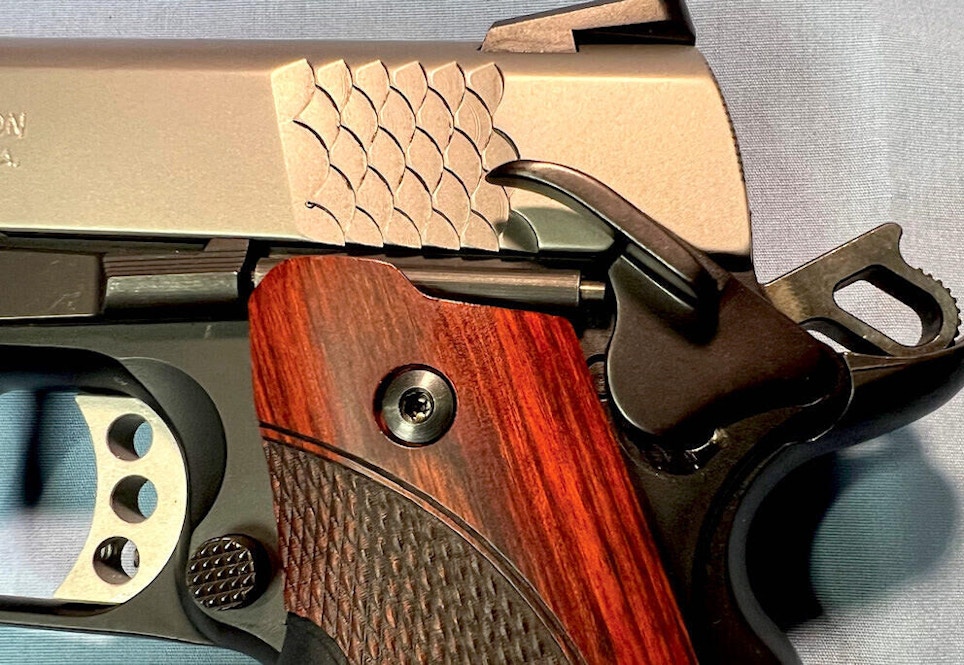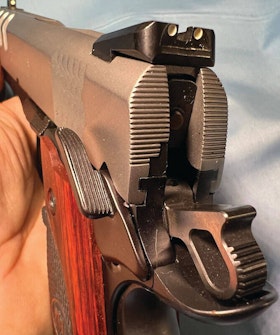Active, passive, frame-mounted, slide mounted, grip, internal, external, drop, transfer bar, double-action, magazine disconnect, decocker, trigger weight, takedown lever spring … handgun safeties come in various types, and how they work is not always obvious.
As a salesperson, you need to know the different types of handgun safeties and how they function, along with the advantages, disadvantages and dynamics of their use. Let’s look at the most common handgun safety features and their practical implications your customers should know.
Col. Jeff Cooper’s response when asked about safeties is famous. He raised his index finger, pointed slightly toward his head, and said, “This is my safety.” There’s speculation over whether he meant to indicate that his trigger finger was his safety or if he was pointing to his brain. Cooper was brilliant, so I suspect he meant both. For a modern handgun to fire, a person must decide (brain) to fire it and pull (finger) the trigger. The problem is that humans are imperfect; even the most careful person can make a mistake when handling a gun. Safeties help minimize accidental discharges.
The first distinction is between active safeties (those requiring specific actions to engage and disengage them) and passive safeties (those that are internal and automatically disengage when the handgun is used). Many people criticize Glock handguns because they “don’t have a safety.” We know that’s not true, but it indicates that many customers are unaware that internal, passive safeties exist. The Glock handgun is a perfect example of three common passive safeties: the trigger lever safety, the firing pin block, and the drop safety.
Passive Safeties
The trigger lever safety is a small pivoting lever that mechanically prevents the trigger from being depressed unless the lever safety is pressed. It prevents accidental trigger movement unless the trigger is fully engaged with a finger. Glock was the first to market such a safety, but its acceptance is indicated by the fact Smith & Wesson, Springfield Armory and Taurus are among the major players now using similar designs.
The firing pin block is another type of safety used for decades. It consists of a plunger that prevents the firing pin (or striker) from moving forward until it is physically moved out of the way by pressing the trigger. It’s sometimes called a drop safety since its purpose was to prevent discharges when a pistol is accidentally dropped. Most, though not all, manufacturers use firing pin block safeties. Colt famously added firing pin blocks when it came out with its “Series 80” 1911s in 1983. The previous “70 Series” does not have a firing pin block. And 1911 enthusiasts still debate which design is better.
The plunger-style firing pin block is just one type of drop safety. Glock pistols, for example, accomplish the task by using the transfer bar to block the striker (firing pin) from moving. As with the other designs, it is only disengaged when the trigger is fully pressed.
There are a few other gun features that can be considered safety features. It may surprise customers to learn that trigger weight is frequently cited as a safety feature. Like their revolver cousins, the Double-Action/Single-Action pistols require a long, heavy trigger pull for the first shot; the following shots then operate in single-action mode, requiring much less effort. The heavy trigger pull requires an intentional act to fire the gun. Once the first round is intentionally fired, it is assumed that those following are also intended. The added weight validates the shooter’s intention.
A prime example is the Glock being used by New York City. The factory trigger weight for Glocks was about 5.5 pounds. New York City police cited the light trigger pull as a factor contributing to unintentional shootings, so the City requested Glock come up with a heavier trigger for their guns. Glock subsequently came out with the New York Trigger with an 8-pound weight, then a New York 2 trigger with a 12-pound pull. These are known as NY1 and NY2 triggers. Notably, the City has since returned to the original 5.5-pound trigger. The actual problem was likely related to officers transitioning from DA revolvers, with their heavy triggers, to the lighter, striker-fired Glocks rather than the trigger weight itself.
There are other types of passive safeties. Almost all 1911-style handguns incorporate grip safeties in their design. Grip Safeties block the trigger and prevent it from being pressed unless the shooter has attained a proper shooting grip on the gun. Springfield Armory’s XD-series and Smith & Wesson’s M&P EZ-Series are additional examples.
The advantage of passive safeties is that they require no thought on the shooter's part. All of them are automatically engaged until a shooter picks up the gun and pulls the trigger. They have proven themselves completely reliable, provided the gun is handled safely. The disadvantage to passive safeties is that they do nothing to prevent a guest or a child from accidentally or carelessly pulling the trigger and firing the gun. I say disadvantage, but passive safeties are not intended to address unauthorized or careless handling. To address those concerns, let’s take a look at active safeties.
Active Safeties
Active safeties differ because they are external devices, requiring the shooter to positively engage or disengage them. They fall into two main categories: frame-mounted and slide-mounted.
The classic example of a frame-mounted safety is the 1911-style handgun. The safety is mounted on the rear of the frame, where it can be easily operated using the thumb. Push the lever up, and the gun is on safe. Push it down, and it’s ready to fire. Frame-mounted safeties are popular, even on other gun designs. Examples can be found among Browning, Beretta, H&K, IWI, Taurus and Sig guns.
Slide-mounted safeties, such as those used in the Beretta 92 and early S&W semi-autos, are familiar and popular designs. They typically disconnect the trigger from the rest of the gun’s action. Some, like on the Beretta 92, also incorporate firing pin disconnects that roll the firing pin out of the way to prevent them from firing. These mechanical safeties provide a barrier to pistol operation that helps prevent accidental firing. They require specific acts to begin the firing sequence and have specific acts after firing.
Active safeties have advantages and disadvantages, especially when considered in a defensive-use situation. There are plenty of stories where a bad guy has disarmed a police officer and found himself unable to shoot the officer because he was unfamiliar with how to operate the safety. This is less likely today but could still be a delaying factor, allowing an officer more time to react to being disarmed. The same applies to the carrying public. This can also serve as a disadvantage. There have been police officers killed when they forgot to disengage the safety in a combat situation. Responding to such incidents requires training and discipline. If a customer decides to carry with the safety engaged, they must practice disengaging it during their draw from the holster. It has to be automatic. Returning the gun to a safe condition should also be practiced until it is intuitive.
Pistol decocking levers/devices are another active safety. These can be frame- or slide-mounted. The Beretta slide-mounted safety has an integrated decocker. When the lever is engaged, it automatically decocks the gun, making it safer to handle by reverting it back to a double-action first shot. Some Sig pistols have a prominent, frame-mounted decocker lever. Sig’s design is separate from its safety. Like the Beretta lever, it’s designed to decock the pistol, returning it to double-action mode.
I’ve distinguished between active and passive safeties but saved one more: the magazine disconnect safety. This safety feature prevents the pistol from firing unless a magazine is inserted. I consider this both passive and active. It’s passive in that no direct action is required above the regular operation of the handgun. It can be active as well. A homeowner can store the gun without a magazine, even with a bullet in the chamber, thus preventing an unauthorized person from using it. The feature can also be used in a self-defense situation. Should someone try to disarm the gun owner, removing the magazine will prevent them from using the gun against them.
Once your customers understand the different types of safeties, how they work, and their practical implications, they can make educated decisions concerning which design suits their particular needs. It’s not a one-size-fits-all situation. They have to choose for themselves after you’ve given them the knowledge. They then must practice to develop proficiency with their choice. The nice thing is that live ammo isn’t required for this training. The necessary skills can be learned at home using only the dummy ammunition you’ll happily sell them.








